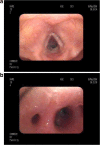A 2-year-old girl with chronic crackles after respiratory syncytial virus infection: a case report
- PMID: 30205845
- PMCID: PMC6134501
- DOI: 10.1186/s13256-018-1797-6
A 2-year-old girl with chronic crackles after respiratory syncytial virus infection: a case report
Abstract
Background: Respiratory syncytial virus is the most common cause of lower respiratory tract infections in infants and young children. While the majority of infants display only mild upper respiratory tract infection or occasionally otitis media, around one-third will develop an infection of the lower respiratory tract, usually bronchiolitis. There is now convincing evidence from a number of cohorts that respiratory syncytial virus is a significant, independent risk factor for later wheezing, at least within the first decade of life. The wide variation in response to respiratory syncytial virus infection suggests that susceptibility and disease are influenced by multiple host-intrinsic factors.
Case presentation: A 2-year-old white girl presented to our Pediatric Allergy Clinic with recurrent crackles in addition to cough, fevers, and labored breathing since her first respiratory syncytial virus infection at the age of 7 months. She had been under the care of pulmonologists, who suspected childhood interstitial lung disease. She was hospitalized eight times due to exacerbation of symptoms and prescribed systemic and inhaled steroids, short-acting β2-mimetics, and antileukotriene. There was no short-term clinical improvement at that time between hospitalizations. During her hospital stay at the Pneumonology and Cystic Fibrosis Department in Rabka a bronchoscopy with bronchoalveolar lavage was performed. Laboratory bacteriological tests found high colony count of Moraxella catarrhalis (β-lactamase positive), sensitive to amoxicillin-clavulanate, in bronchial secretions and swabs from her nose. After this, infections were treated with antibiotics; she remained in good condition without symptoms. Crackles and wheezing recurred only during symptoms of infections. Therefore, we hypothesize that respiratory syncytial virus infection at an early age might cause severe damage of the lung epithelium and prolonged clinical symptoms, mainly crackles and wheezing, each time the child has a respiratory infection.
Conclusions: This case illustrates the importance of respiratory syncytial virus infection in an immunocompetent child. Pediatricians need to have a high index of suspicion and knowledge of recurrent symptoms associated with severe damage of the lung epithelium to establish the correct diagnosis.
Keywords: Infections; Interstitial lung disease (ILD); Pneumonia; RSV; Viral.
Conflict of interest statement
Ethics approval and consent to participate
The consent from the caregivers was obtained.
Consent for publication
Written informed consent was obtained from the patient’s legal guardian(s) for publication of this case report and any accompanying images. A copy of the written consent is available for review by the Editor-in-Chief of this journal.
Competing interests
The authors declare that they have no competing interests.
Publisher’s Note
Springer Nature remains neutral with regard to jurisdictional claims in published maps and institutional affiliations.
Figures
Similar articles
-
Rhinovirus-associated wheezing in infancy: comparison with respiratory syncytial virus bronchiolitis.Pediatr Infect Dis J. 2004 Nov;23(11):995-9. doi: 10.1097/01.inf.0000143642.72480.53. Pediatr Infect Dis J. 2004. PMID: 15545853
-
Comparison of human metapneumovirus, respiratory syncytial virus and influenza A virus lower respiratory tract infections in hospitalized young children.Pediatr Infect Dis J. 2006 Apr;25(4):320-4. doi: 10.1097/01.inf.0000207395.80657.cf. Pediatr Infect Dis J. 2006. PMID: 16567983
-
Impact of wheezing after respiratory syncytial virus infection on health-related quality of life.Pediatr Infect Dis J. 2004 May;23(5):414-7. doi: 10.1097/01.inf.0000122604.32137.29. Pediatr Infect Dis J. 2004. PMID: 15131463
-
Bronchiolitis in infants.Curr Opin Pediatr. 2001 Jun;13(3):256-60. doi: 10.1097/00008480-200106000-00008. Curr Opin Pediatr. 2001. PMID: 11389361 Review.
-
Long-term consequences of respiratory syncytial virus (RSV) bronchiolitis.Paediatr Respir Rev. 2000 Sep;1(3):221-7. doi: 10.1053/prrv.2000.0052. Paediatr Respir Rev. 2000. PMID: 12531083 Review.
References
-
- Spagnolo P, Bush A. Interstitial Lung Disease in Children Younger Than 2 Years. Pediatrics. 2016;137(6) 10.1542/peds.2015-2725. - PubMed
Publication types
MeSH terms
Substances
LinkOut - more resources
Full Text Sources
Other Literature Sources
Medical


